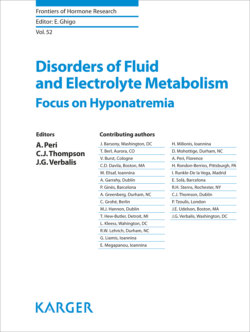Читать книгу Disorders of Fluid and Electrolyte Metabolism - Группа авторов - Страница 47
На сайте Литреса книга снята с продажи.
Hyponatremia in Geriatric Patients
ОглавлениеAn increase in hyponatremia prevalence with higher age was reported in studies of both, hospitalized patients [16] and the general population [23, 25]. This can be explained by several factors including the kidney’s declining capacity with age to produce a maximally dilute urine [27], the increasing incidence of age-related diseases that may induce hyponatremia, and the higher frequency of drug prescriptions in older patients that may elicit or facilitate hyponatremia. Moreover, several studies revealed that patients found to be hyponatremic were older and that the mean age increased with hyponatremia severity [17, 20, 21]. Several studies focusing on geriatric patients in long-term care institutions and nursing homes over the last four decades reported a hyponatremia prevalence in the range of 11.3–22.5% [28–30]. In 2012, Mannesse et al. [31] conducted a meta-analysis collating data from 53 studies since 1966, and calculated the pooled estimated mean prevalence for mild community-acquired hyponatremia (serum [Na+] <135 mEq/L) to be 22.2% for patients in geriatric wards but only 6.0% for non-geriatric inpatients. Severe hyponatremia (serum [Na+] <125 mEq/L) was found in 4.5 and 0.8%, respectively [31]. Of note, these epidemiologic figures did not change significantly over the entire time span from 1966 to 2006.
Recently, Gosch et al. [32] performed a retrospective analysis on 2,880 patients that were admitted consecutively to a geriatric inpatient service in Hochzirl (Austria). They found an overall hyponatremia prevalence of 16.7%, with the lowest rate in patients between 65 and 69 years (12.2%) and the highest rate in patients older than 90 years (22.4%). They also showed a significant shift from mild to more severe forms of hyponatremia with increasing age. Various analyses reported associations in the geriatric population between hyponatremia of mild-to-moderate degree and increased frequency of falls [33] and bone fractures [34, 35], rate of delirium [36] and cognitive malfunction [32], risk for development of dementia [37], as well as mortality [36]. However, whether there is a true causal relationship and, in turn, whether effective correction of hyponatremia has a beneficial impact on these adverse outcomes in old persons is not clear. Another area of uncertainty is the normal range of serum [Na+] in older individuals. Overseeing data from more than 110,000 patients, McKee et al. [38] calculated that the mean serum [Na+] was lower and the range wider in hospitalized patients >65 years as the usually applied reference values derived from healthy young individuals.
